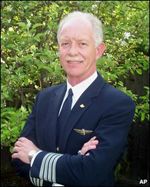 In his first major interview with the mainstream press Sunday night, USAir’s Chesley B. Sullenberger described the moment after his Airbus 320 ingested birds as “the worst, sickening pit of your stomach, falling through the floor feeling I’ve ever felt in my life. I knew immediately it was very bad.” In a 20-minute interview with CBS’s Katie Couric on 60 Minutes, Sullenberger said he and F/O Jeff Skiles went through a brief moment of denial before getting to work of ditching the stricken USAir Flight 1549 in the Hudson River on January 15. “My initial reaction was one of disbelief this is happening. This doesn’t happen to me,” he told Couric, adding that he expected to finish his entire flying career without ever having lost an airplane. Sullenberger described the birdstrike impacts as “like a hailstorm…like the worst thunderstorm I’d ever experienced growing up in Texas.” When he noticed the smell of burned birds passing through the air packs, Sullenberger realized the engines weren’t going to restart, although he and Skiles selected continuous ignition and started the APU, which apparently provided power all the way to the ditching. “No luck. I mean, I got the AP running, I turned the ignition on, but still, no usable thrust. We were descending rapidly toward the water. The water was coming up at us fast,” he told Couric.
In his first major interview with the mainstream press Sunday night, USAir’s Chesley B. Sullenberger described the moment after his Airbus 320 ingested birds as “the worst, sickening pit of your stomach, falling through the floor feeling I’ve ever felt in my life. I knew immediately it was very bad.” In a 20-minute interview with CBS’s Katie Couric on 60 Minutes, Sullenberger said he and F/O Jeff Skiles went through a brief moment of denial before getting to work of ditching the stricken USAir Flight 1549 in the Hudson River on January 15. “My initial reaction was one of disbelief this is happening. This doesn’t happen to me,” he told Couric, adding that he expected to finish his entire flying career without ever having lost an airplane. Sullenberger described the birdstrike impacts as “like a hailstorm…like the worst thunderstorm I’d ever experienced growing up in Texas.” When he noticed the smell of burned birds passing through the air packs, Sullenberger realized the engines weren’t going to restart, although he and Skiles selected continuous ignition and started the APU, which apparently provided power all the way to the ditching. “No luck. I mean, I got the AP running, I turned the ignition on, but still, no usable thrust. We were descending rapidly toward the water. The water was coming up at us fast,” he told Couric.
Sullenberger was aware of at least one previous ditching gone bad-the 1996 ditching of a hijacked Air Ethiopia 767 in which 125 of 175 people died, largely because the airplane didn’t touch down nose-up with wings level. “I needed to touch down with the wings exactly level. I needed to touch down with the nose slightly up. I needed to touch down at a descent rate that was survivable. And I needed to touch down just above our minimum flying speed but not below it. And I needed to make all these things happen simultaneously,” he told Couric.
Once the airplane had impacted the water and come to rest, Sullenberger and Skiles turned to each other “and we said, ‘Well, that wasn’t as bad as I thought.'” However, flight attendant Doreen Welsh had a different experience from her seat in the rear of the cabin. “The back of the plane hit first…it was violent. Horrible. Things flew out,” Welsh said. Although the evacuation was orderly, Welsh said there was “some panic in the back,” but despite significant flooding, all of the 155 occupants of the airplane evacuated safely.
The FA’s only had about 90 seconds warning that the aircraft was making an emergency touchdown and none realized they were going into the river. Welsh injured her leg either during the impact or evacuation and she told Couric she’s still too traumatized to put her USAir uniform back on. Sullenberger credits the cabin crew and especially the boat handlers and first responders with making the evacuation a success. For CBS’s full story, see www.cbsnews.com.


































